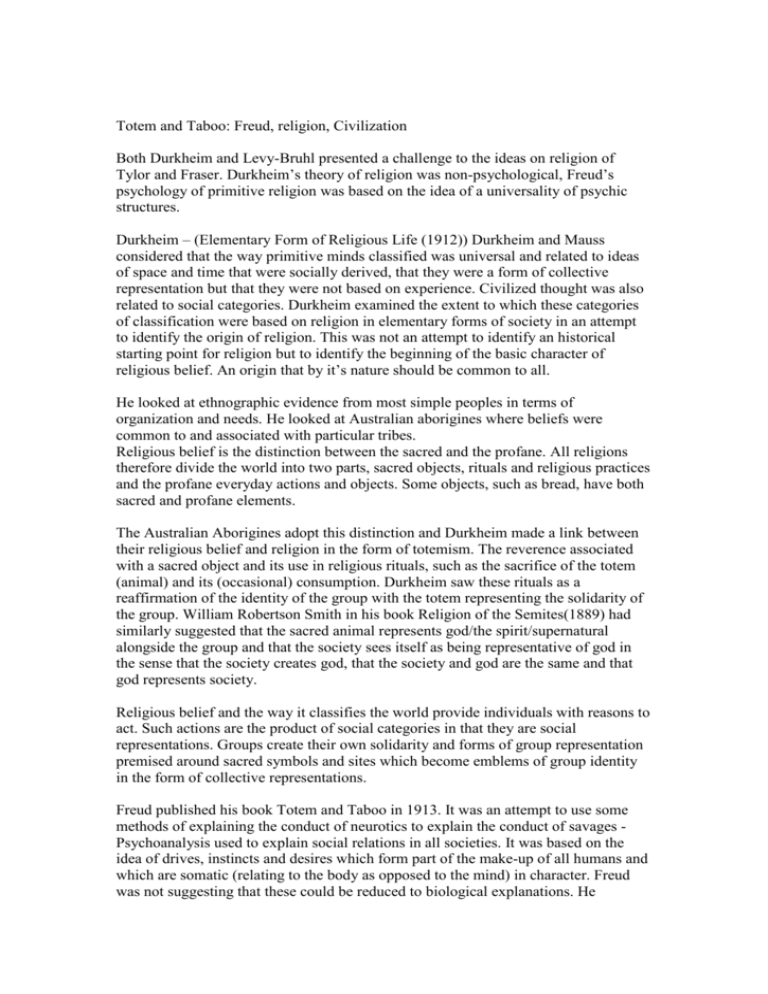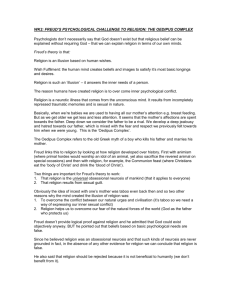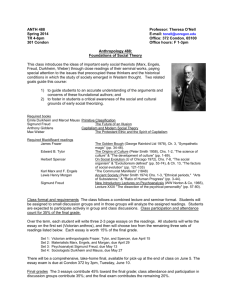Totem and taboo : Freud, religion, Civilization
advertisement

Totem and Taboo: Freud, religion, Civilization Both Durkheim and Levy-Bruhl presented a challenge to the ideas on religion of Tylor and Fraser. Durkheim’s theory of religion was non-psychological, Freud’s psychology of primitive religion was based on the idea of a universality of psychic structures. Durkheim – (Elementary Form of Religious Life (1912)) Durkheim and Mauss considered that the way primitive minds classified was universal and related to ideas of space and time that were socially derived, that they were a form of collective representation but that they were not based on experience. Civilized thought was also related to social categories. Durkheim examined the extent to which these categories of classification were based on religion in elementary forms of society in an attempt to identify the origin of religion. This was not an attempt to identify an historical starting point for religion but to identify the beginning of the basic character of religious belief. An origin that by it’s nature should be common to all. He looked at ethnographic evidence from most simple peoples in terms of organization and needs. He looked at Australian aborigines where beliefs were common to and associated with particular tribes. Religious belief is the distinction between the sacred and the profane. All religions therefore divide the world into two parts, sacred objects, rituals and religious practices and the profane everyday actions and objects. Some objects, such as bread, have both sacred and profane elements. The Australian Aborigines adopt this distinction and Durkheim made a link between their religious belief and religion in the form of totemism. The reverence associated with a sacred object and its use in religious rituals, such as the sacrifice of the totem (animal) and its (occasional) consumption. Durkheim saw these rituals as a reaffirmation of the identity of the group with the totem representing the solidarity of the group. William Robertson Smith in his book Religion of the Semites(1889) had similarly suggested that the sacred animal represents god/the spirit/supernatural alongside the group and that the society sees itself as being representative of god in the sense that the society creates god, that the society and god are the same and that god represents society. Religious belief and the way it classifies the world provide individuals with reasons to act. Such actions are the product of social categories in that they are social representations. Groups create their own solidarity and forms of group representation premised around sacred symbols and sites which become emblems of group identity in the form of collective representations. Freud published his book Totem and Taboo in 1913. It was an attempt to use some methods of explaining the conduct of neurotics to explain the conduct of savages Psychoanalysis used to explain social relations in all societies. It was based on the idea of drives, instincts and desires which form part of the make-up of all humans and which are somatic (relating to the body as opposed to the mind) in character. Freud was not suggesting that these could be reduced to biological explanations. He considered them to be part of the psychic make-up; the relation of the human brain to the culture, experiences and environment of the individual, and as such he considered it important to investigate these drivers and instincts. In 1913 he proposed two theories of what these drives are 1. Sexual (The pleasure principle) and 2. Self-preservation. (Post 1920 he proposed a third – 3. The death instinct (beyond the pleasure principle)). IN his early studies Freud focused on neurotics (particularly hysterics) in order to understand their delusions about the nature of the world. Contemporary ideas were that neuroses were the result of internal faults in the chemistry of the body – that they were organic problems. Freud was of the opinion that delusions were the sign of an event in the past of an individual such as an abnormal event and that the cure was in the ability to recreate or discover this event. This led to his interest in dreams and slips in speech and action that might provide clues to these past events (The Interpretation of Dreams 1900), because they indicated signs of activity in the unconscious mind. For instance the neurotics inability to repress sexual desire found an outlet in the unconscious mind. Freud’s attitude to sexual energy (libido) was that infants had a diffuse libido. They had a desire for pleasure that was not concentrated on any particular object or body part but that this becomes channelled onto certain objects or body parts. The aim of human society is to channel infant sexuality along certain pathways – genitality – in order to encourage the need to reproduce. This becomes a cultural aspect of family life. In all human society family life is the same with sexuality as an object of reproduction and as a result of sexual activity with the opposite sex. As a result there are elements of forbidden sex such as with /between the mother, sister, father, brother and it is these exclusions that Freud says give rise to a universal idea of incest taboo. The question is why does this arise? Freud argues that in early life the infant develops an attachment for the mother (Oedipus complex). Pre-puberty this desire is quashed by the father and gives rise to a castration complex within the child – the father (or father figure) is a symbol of authority who threatens the son which results in the cessation of desire for the mother. (with girls a similar relationship arises as a result of penis-envy and an attraction for the father) The excluded desire for the mother results in/is transferred to genital sexuality. “Totem and Taboo” is about how the Oedipus complex and incest taboo came into being and why they are present in all human societies. There are many social prohibitions on sexual relations, they are not always closely related and are not to do with eugenics. The incest taboo arises because of a desire for incest (otherwise there would not be a need for a taboo). The purpose of the totemic animal is not for group solidarity but to re-enforce the incest taboo. The totemic animal is not a symbol of God but a symbol of the father, (following on from Robertson Smith) and is an important part of religious development. It corresponds with Darwin’s idea of the ancestors of human society living in groups dominated by a single male who prohibits sex between other males in the group and the females. Totemism originates from the memory of a real event in pre-history where the male group members, as a result of their desire for the females overthrow and eat the father figure. The resulting guilt they feel for their actions and from the loss of the father leads them to prohibit incest in a novel way. Hence totemism is a means of preventing incest and as a ritual reminder of the murder of the father. It is an important point that this is a universal explanation of sexual desire channelled through certain ritual actions and that all societies, including modern, adopt these rituals. They are designed to ensure that sexuality develops in prescribed ways. Totemism reveals unconscious desires and their repression. (Note that there is no ethnographic evidence for the murder of the father conjecture) Freud counters cultural reductions, by arguing that these are not collective representations as described by Durkheim. It cannot be that simple. It is a question of how individual minds are structured and how social relations reflect and manage individual psychic make-up. Behaviour is a complex relationship between both the biological and psychological functions and social relations. The modern approach is to look at group psychology and the ego in an attempt to discover the ties that bind groups together and that instil a sense of belonging. There remains the idea of identification with a father figure/leader who is both feared and loved, and it is one reason why people follow charismatic individuals ( 1920’s and 30’s dictatorships were led by charismatic leaders). These ties are important in considering how groups are held together and their relationship to founding myths and symbols. Freud discusses this in “Civilization and its Discontents” along with his belief that civilization makes people unhappy because it contradicts the desire for progress, freedom, happiness and wealth. Civilization requires repression of drives and instincts such as sexual, aggression, the death instinct in order that civilization can work. People can be made to hold certain other beliefs and attitudes. A consequence of this is the development of religious institutions in order to control and help us abandon our desires. The absence of these controls and the recognition of desires and instincts is what makes individuals in primitive societies happier and ensures they remain primitive and not civilized









